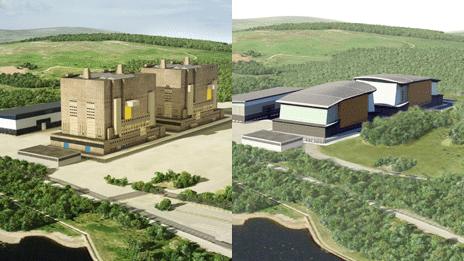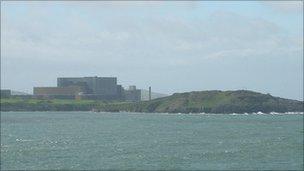Trawsfynydd nuclear station decommission speed-up plan
- Published

A computer generated image showing how the towers will look in 2015 and 2025
The clean-up at the Trawsfynydd nuclear power station could be speeded up if Nuclear Decommissioning Authority (NDA) business plans are given the go-ahead.
If approved the workforce would increase by 200 so that the current phase of the decommissioning is completed by 2016 instead of 2022.
It would mean more than 800 are employed, up from the 620 currently working there.
But work to lower the towers would not begin until around 2020.
The plan to speed up the process was first mooted in July and is now been included in the proposed budget of £86m for 2011/12.
It would see the pace of work increase with the aim of reaching the "care and maintenance" stage six years sooner than planned.
There are currently 620 people working at the station - roughly two thirds of them employed by contractors. Around 600 worked at the plant when it generated electricity between the mid-1960s and 1991.
The new jobs would be with contractors with the maximum number reached by the end of 2014 - then the workforce would slowly reduce as work nears completion.
'Care and maintenance'
In terms of lowering the towers the work had been scheduled to finish by 2022, but that date has now moved back to 2025.
Site director Dr Phil Sprague said Trawsfynydd was "firmly at the front of nuclear decommissioning in the UK" for a number of years.
He said if the funding was made available it could be the first of the UK's Magnox nuclear power station to reach the "care and maintenance" stage.
That stage will last until 2065 when the nuclear waste is deemed safe enough to remove.
The timing too could help workers who wanted to stay in the nuclear industry, he added.

Jobs could be created if a Wylfa B is built on Anglesey
"It is hoped that around 2016 that construction of a new nuclear power station will be underway at Wylfa on Anglesey," he said.
Staff and contractors who wished to remain in the nuclear industry could do so if that happened, he added.
"For others we recently announced a £4.2m package of funding to retrain and re-skill our staff to work in other industries," he added.
The eight-week public consultation period will last until January.
Subject to both the UK and Scottish Governments the final version of the business plan will be published by the end of March.
- Published1 July 2010
- Published19 June 2010
- Published13 October 2010
- Published1 November 2010